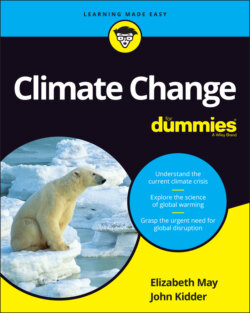Читать книгу Climate Change For Dummies - Elizabeth May - Страница 41
Focusing On Carbon Dioxide: Leader of the Pack
ОглавлениеEarth’s atmosphere contains 24 different GHGs, but just one of them accounts for the overwhelming majority of the effect: carbon dioxide (or CO2, for short). This gas accounts for about 63 percent of the GHG warming effect in the long run. (In the short term, over the last 5 years, it has accounted for 91 percent. See Table 2-1 for more on the intensity of gases over time.) If you’re itching to know about the other 37 percent of greenhouse warming, check out the section “Checking Out the Other GHGs,” later in this chapter.
Water vapor, not carbon dioxide, is technically the GHG with the biggest impact. But human activities don’t directly affect in a significant way water vapor in the atmosphere.
Given the important role that carbon dioxide plays in warming the Earth, you may be surprised by how little of it is in the atmosphere.
In fact, 99.95 percent of the air that humans breathe (not including water vapor) is made up of
Nitrogen: 78 percent
Oxygen: 21 percent
Argon: 0.95 percent
Carbon dioxide, by contrast, currently makes up only 0.0412 percent of all the air in the atmosphere. Human activities have helped increase that concentration from pre-industrial times, when it was about 0.0280 percent.
When scientists talk about air quality and the chemistry of the atmosphere, they often use the term parts per million (ppm). So, currently out of every million parts of air, only 412 are carbon dioxide. That’s not much carbon dioxide, but what a difference it makes! Until recent changes in atmospheric chemistry caused by human activity, for around the last million years, carbon dioxide concentrations never exceeded 285 ppm. It’s like the hot pepper you put into a pot of chili — just right is just right, but if you have just a little too much, watch out.
The next sections explain the carbon cycle. If not for humans digging up the fossilized stored carbon of millennia ago — called fossil fuels — the Earth’s carbon cycle would have remained in balance. However, now the carbon cycle is out of balance. And that’s a key reason the weather and climate are no longer so hospitable.
